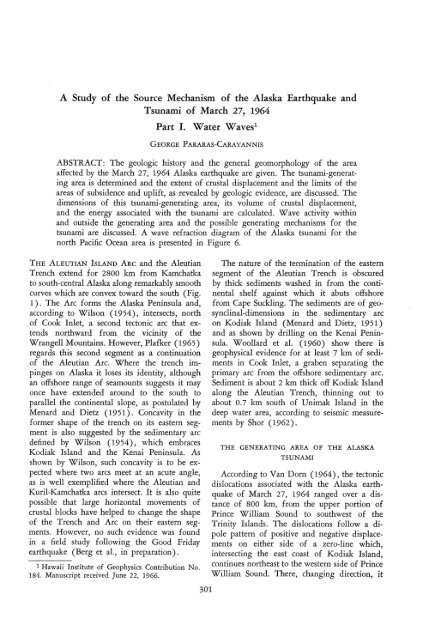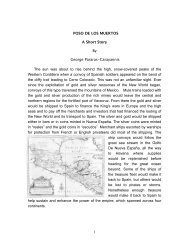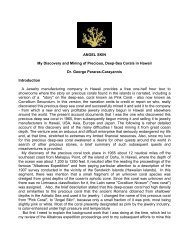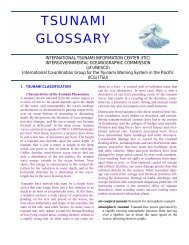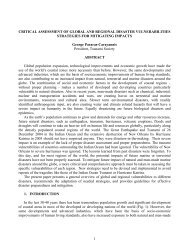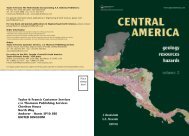A Study of the Source Mechanism of the Alaska Earthquake and ...
A Study of the Source Mechanism of the Alaska Earthquake and ...
A Study of the Source Mechanism of the Alaska Earthquake and ...
You also want an ePaper? Increase the reach of your titles
YUMPU automatically turns print PDFs into web optimized ePapers that Google loves.
A <strong>Study</strong> <strong>of</strong> <strong>the</strong> <strong>Source</strong> <strong>Mechanism</strong> <strong>of</strong> <strong>the</strong> <strong>Alaska</strong> <strong>Earthquake</strong> <strong>and</strong>Tsunami <strong>of</strong> March 27, 1964Part 1. Water Waves!GEORGE PARARAS-CARAYANNISABSTRACT: The geologic history <strong>and</strong> <strong>the</strong> general geomorphology <strong>of</strong> <strong>the</strong> areaaffected by <strong>the</strong> March 27, 1964 <strong>Alaska</strong> earthquake are given. The tsunami-generatingarea is determ ined <strong>and</strong> <strong>the</strong> extent <strong>of</strong> crustal displacement <strong>and</strong> <strong>the</strong> limits <strong>of</strong> <strong>the</strong>areas <strong>of</strong> subsidence <strong>and</strong> uplift, as revealed by geologic evidence, are discussed. Thedimensions <strong>of</strong> this tsunami-generating area, its volume <strong>of</strong> crustal displacement,<strong>and</strong> <strong>the</strong> energy associated with <strong>the</strong> tsunami are calculated. Wave activity within<strong>and</strong> outside <strong>the</strong> generating area <strong>and</strong> <strong>the</strong> possible generating mechanisms for <strong>the</strong>tsunami are discussed. A wave refraction diagram <strong>of</strong> <strong>the</strong> <strong>Alaska</strong> tsunami for <strong>the</strong>north Pacific Ocean area is presented in Figure 6.THE ALEUTIAN ISLAND ARC <strong>and</strong> <strong>the</strong> AleutianTrench extend for 2800 km from Kamchatkato south-central <strong>Alaska</strong> along remarkably smoothcurves which are convex toward <strong>the</strong> south (Fig.1). The Arc forms <strong>the</strong> <strong>Alaska</strong> Peninsula <strong>and</strong>,according to Wilson (1954), intersects, north<strong>of</strong> Cook Inlet, a second tectonic arc that extendsnorthward from <strong>the</strong> vicinity <strong>of</strong> <strong>the</strong>Wrangell Mountains. However, Plafker (1965)regards this second segment as a continuation<strong>of</strong> <strong>the</strong> Aleutian Arc. Where <strong>the</strong> trench impingeson <strong>Alaska</strong> it loses its identity, althoughan <strong>of</strong>fshore range <strong>of</strong> seamounts suggests it mayonce have extended around to <strong>the</strong> south toparallel <strong>the</strong> continental slope, as postulated byMenard <strong>and</strong> Dietz (1951). Concavity in <strong>the</strong>former shape <strong>of</strong> <strong>the</strong> trench on its eastern segmentis also suggested by <strong>the</strong> sedimentary arcdefined by Wilson (1954), which embracesKodiak Isl<strong>and</strong> <strong>and</strong> <strong>the</strong> Kenai Peninsula. Asshown by Wilson, such concavity is to be expectedwhere two arcs meet at an acute angle,as is well exemplified where <strong>the</strong> Aleutian <strong>and</strong>Kuril-Kamchatka arcs intersect. It is also quitepossible that large horizontal movements <strong>of</strong>crustal blocks have helped to change <strong>the</strong> shape<strong>of</strong> <strong>the</strong> Trench <strong>and</strong> Arc on <strong>the</strong>ir eastern segments.However, no such evidence was foundin a field study following <strong>the</strong> Good Fridayearthquake (Berg et al., in preparation) .i Hawaii Institute <strong>of</strong> Geophysics Contribution No .184. Manuscript received June 22, 1966.301The nature <strong>of</strong> <strong>the</strong> termination <strong>of</strong> <strong>the</strong> easternsegment <strong>of</strong> <strong>the</strong> Aleutian Trench is obscuredby thick sediments washed in from <strong>the</strong> continental shelf against which it abuts <strong>of</strong>fshorefrom Cape Suckling. The sediments are <strong>of</strong> geosynclinal-dimensionsin <strong>the</strong> sedimentary arcon Kodiak Isl<strong>and</strong> (Menard <strong>and</strong> Dietz, 1951)<strong>and</strong> as shown by drilling on <strong>the</strong> Kenai Peninsula.Woollard et al. (1960) show <strong>the</strong>re isgeophysical evidence for at least 7 km <strong>of</strong> sedimentsin Cook Inlet, a graben separating <strong>the</strong>primary arc from <strong>the</strong> <strong>of</strong>fshore sedimentary arc.Sediment is about 2 km thick <strong>of</strong>f Kodiak Isl<strong>and</strong>along <strong>the</strong> Aleutian Trench, thinning out toabout 0.7 km south <strong>of</strong> Unimak Isl<strong>and</strong> in <strong>the</strong>deep water area, according to seismic measurementsby Shor (1962).THE GENERATING AREA OF THE ALASKATSUNAMIAccording to Van Dorn (1964) , <strong>the</strong> tectonicdislocations associated with <strong>the</strong> <strong>Alaska</strong> earthquake<strong>of</strong> March 27, 1964 ranged over a distance<strong>of</strong> 800 km, from <strong>the</strong> upper portion <strong>of</strong>Prince William Sound to southwest <strong>of</strong> <strong>the</strong>Trinity Isl<strong>and</strong>s . The dislocations follow a dipolepattern <strong>of</strong> positive <strong>and</strong> negative displacementson ei<strong>the</strong>r side <strong>of</strong> a zero-line which,intersecting <strong>the</strong> east coast <strong>of</strong> Kodiak Isl<strong>and</strong>,continues nor<strong>the</strong>ast to <strong>the</strong> western side <strong>of</strong> PrinceWilliam Sound. There, changing direction, it
<strong>Alaska</strong> <strong>Earthquake</strong> <strong>and</strong> Tsunami, I-PARARAS-CARAYANNIS 303is greater than <strong>the</strong> 1906 San Francisco earthquake( 8.3) , <strong>and</strong> equal to or greater than <strong>the</strong>1960 Chile earthquake (8.4). The epicenter<strong>of</strong> <strong>the</strong> earthquake was at 61.05 °N, 147.7°W(USCGS, 1964) , near <strong>the</strong> east shore <strong>of</strong> UnakwikInlet in nor<strong>the</strong>rn Prince William Sound .Geological investigations have defined <strong>the</strong>l<strong>and</strong> areas affected by <strong>the</strong> earthquake. To <strong>the</strong>east, <strong>the</strong> zone <strong>of</strong> deformation appears to die outbetween <strong>the</strong> Bering Glacier <strong>and</strong> Cape Yakataga .The northwestern limit <strong>of</strong> tectonic changesextends at least to <strong>the</strong> west side <strong>of</strong> Shelik<strong>of</strong>Strait <strong>and</strong> Cook Inlet (Plafker , 1965) . Thenorth inl<strong>and</strong> limit is known only along <strong>the</strong>highway connecting Valdez <strong>and</strong> Fairbanks; itappears to extend in a nor<strong>the</strong>asterly directionto <strong>the</strong> vicinity <strong>of</strong> <strong>the</strong> Wrangell Mountains, <strong>and</strong>quite possibly into <strong>the</strong> <strong>Alaska</strong> Range.The area <strong>of</strong> uplift covers about 105,000 km<strong>and</strong>extend s from sou<strong>the</strong>rn Kodiak Isl<strong>and</strong> nor<strong>the</strong>astto Prince William Sound . It includes <strong>the</strong>sou<strong>the</strong>rn <strong>and</strong> eastern parts <strong>of</strong> Prince WilliamSound , <strong>the</strong> coastal area as far east as <strong>the</strong> BeringGlacier, <strong>and</strong> <strong>the</strong> continental shelf <strong>and</strong> part <strong>of</strong><strong>the</strong> slope to a depth contour <strong>of</strong> approximately200 m. The maximum uplift on l<strong>and</strong> was 10 mat <strong>the</strong> southwest end <strong>of</strong> Montague Isl<strong>and</strong>, butis suspected to have been considerably more <strong>of</strong>fshore.Uplift also occurred along <strong>the</strong> extremesou<strong>the</strong>astern coasts <strong>of</strong> Kodiak Isl<strong>and</strong> <strong>and</strong> SitkalidakIsl<strong>and</strong> , <strong>and</strong> part or all <strong>of</strong> Sitkinak Isl<strong>and</strong>.The maximum measured uplift <strong>of</strong> SitkalidakIsl<strong>and</strong> was 0.4 m. The estimated uplift <strong>of</strong> SitkinakIsl<strong>and</strong> was from 0.35 to 0.65 m <strong>and</strong> possiblyas much as 1.5 m ( Plafker, 1965).The area that subsided included <strong>the</strong> nor<strong>the</strong>rn<strong>and</strong> western parts <strong>of</strong> Prince William Sound,<strong>the</strong> western segment <strong>of</strong> <strong>the</strong> Chugach Mounta ins,portions <strong>of</strong> <strong>the</strong> lowl<strong>and</strong>s north <strong>of</strong> <strong>the</strong>m, most<strong>of</strong> <strong>the</strong> Ken ai Peninsula, <strong>and</strong> almost all <strong>of</strong> <strong>the</strong>Kodiak Isl<strong>and</strong> gro up. This area <strong>of</strong> subsidencecovers approximately 110,000 krn-, <strong>and</strong> is800 km long <strong>and</strong> 150 km wide. Plafker (1965)estimates that <strong>the</strong> volume <strong>of</strong> crust that has beendepressed below its pre-earthquake level is about115 krn",The seaward limits <strong>of</strong> <strong>the</strong> earthquake <strong>and</strong> <strong>the</strong>tsunami-generating area were determined bymeans <strong>of</strong> a series <strong>of</strong> refraction diagrams basedon Snell's Law <strong>of</strong> Refraction using <strong>the</strong> velocityequation for shallow water waves, C = Vgd.Such a method <strong>of</strong> preparing refracti on diagramshas shown good results, especially if carried outon large-scale charts with detailed bathymetry(Johnson, O'Brien, <strong>and</strong> Isaacs, 1948) .In constructi ng <strong>the</strong> refraction diagrams for<strong>the</strong> <strong>Alaska</strong> tsunami, <strong>the</strong> marigrams <strong>of</strong> differenttide gauge stations around <strong>the</strong> Pacific were consulted<strong>and</strong> <strong>the</strong> total travel time <strong>of</strong> <strong>the</strong> first waveat each station was determined. Then refractio ndiagrams were constructed toward <strong>the</strong> earthquakearea from each tide gauge station inlengths <strong>of</strong> time equal to <strong>the</strong> calculated traveltime for that station. It was assumed that <strong>the</strong>last wave front in each refraction diagram wouldcorrespond to a point on <strong>the</strong> boundary <strong>of</strong> <strong>the</strong>generating area, <strong>and</strong> if enough refracted wavefronts from different stations were plotted, anenvelope defining <strong>the</strong> tsunami-generating areacould be drawn.W ave fronts were refracted from Yakatat,Cape Yakataga, Seward, Uzinki, Kodiak, OldHarbor, Unalaska, Adak , Attu , <strong>and</strong> Honolulu .The last front <strong>of</strong> each <strong>of</strong> <strong>the</strong> refracted waves isshown by a heavy dashed line in Figure 1. Theseaward boundary <strong>of</strong> <strong>the</strong> generating area is near<strong>the</strong> 200-m depth contour which defines <strong>the</strong> edge<strong>of</strong> <strong>the</strong> continental shelf. Maximum displacement<strong>of</strong> <strong>the</strong> ocean floor occurred along <strong>the</strong> continentalshelf, from an area south east <strong>of</strong> Kodiak Isl<strong>and</strong>,to an area close to Cape St. Elias south <strong>of</strong> <strong>the</strong>isl<strong>and</strong> <strong>of</strong> Kayak (Fig. 1) . Geologic evidence,however, has shown positive l<strong>and</strong> displacementsas far north as Cape Suckling <strong>and</strong> as far eastas <strong>the</strong> Bering Glacier. It is quite prob able, <strong>the</strong>refore,that <strong>the</strong> tsunami-generating area extendedfar<strong>the</strong>r to <strong>the</strong> nor<strong>the</strong>ast, although waves generatedin such shallow water would reach tidegauges much later <strong>and</strong> <strong>the</strong>ir origin would notbe identifiable.Unfortun ately, this same wave refraction techniquecould not be used to define <strong>the</strong> nor<strong>the</strong>rn<strong>and</strong> western boundaries <strong>of</strong> <strong>the</strong> main tsunamigeneratingarea, because conditions in PrinceWilliam Sound <strong>and</strong> elsewhere along <strong>the</strong> coast<strong>of</strong> <strong>Alaska</strong> were fur<strong>the</strong>r complicated by localtsunamis, oscillations, <strong>and</strong> surge . In addition,no tide gauge stations were operating in <strong>the</strong>area, <strong>and</strong> personal accounts were conflicting asto arrival times <strong>of</strong> <strong>the</strong> different waves.The northward limit is assumed to be restrictedby <strong>the</strong> l<strong>and</strong> boundaries, <strong>and</strong> <strong>the</strong> western
304limit to extend to <strong>the</strong> west side <strong>of</strong> Shelik<strong>of</strong>Strait <strong>and</strong> Cook Inlet.In estimating <strong>the</strong> travel time <strong>of</strong> <strong>the</strong> tsunami,corrections were made for <strong>the</strong> delay at <strong>the</strong> isl<strong>and</strong><strong>of</strong> Kodiak in <strong>the</strong> arrival <strong>of</strong> <strong>the</strong> groundshocks from Prince William Sound. These correctionsranged from 1 minute to 6 minutes <strong>and</strong>were based on <strong>the</strong> fact that <strong>the</strong> Navy W ea<strong>the</strong>rCentr al on <strong>the</strong> isl<strong>and</strong> <strong>of</strong> Kodiak listed <strong>the</strong> time<strong>of</strong> <strong>the</strong> principal shock in Prince W illiam Soundas 6 minutes later than <strong>the</strong> time listed by <strong>the</strong>U. S. Coast <strong>and</strong> Geodetic Survey. This wouldimply that <strong>the</strong> wave front generated on <strong>the</strong>nor<strong>the</strong>ast side <strong>of</strong> <strong>the</strong> disturbance area had a 6minute head start on <strong>the</strong> wave front generatedsou<strong>the</strong>ast <strong>of</strong> Kodiak.The tsunami-generating area covers an area700 km long by 150 km wide, a total <strong>of</strong> about105,000 krn-, The volume <strong>of</strong> <strong>the</strong> uplifted crustalong <strong>the</strong> continental shelf is about 96 krn". Theenergy associated with <strong>the</strong> tsunami has beenestimated by Van Dorn ( 1964) to be <strong>of</strong> <strong>the</strong>order <strong>of</strong> 2.3 X 10 21 ergs. This estimate is basedon <strong>the</strong> source dimensions <strong>of</strong> an area 240 nauticalmiles by 100 nautical miles <strong>and</strong> an uplift<strong>of</strong> 1.8 m ( 6 ft ) at <strong>the</strong> nor<strong>the</strong>astern end <strong>of</strong> thisarea <strong>and</strong> zero at <strong>the</strong> southwestern end. Thisestimate, however, is considered low because <strong>the</strong>generating area had dimensions that were largerthan those estimated by Van Dorn.Using our source dimensions, <strong>and</strong> assumingthat <strong>the</strong> total energy was equal to <strong>the</strong> potent ialenergy <strong>of</strong> <strong>the</strong> uplifted volume <strong>of</strong> water, <strong>the</strong>total energy for <strong>the</strong> tsunami in <strong>the</strong> Gu lf <strong>of</strong><strong>Alaska</strong> was calculated as follows:1E t = - pgh 2 A61= - (1.03) ( .980) (1 0 3 ) (10 4 ) ( 1.8 3 2 ) (1.56X 10 7 ) (7 X 10 7 ) = 5.88 X 10 21 ergswhereE, = E" = total energyp = 1.03 g/cm 3 = densityg = 980 cm/sec 2h = height <strong>of</strong> displacement = 1.83 mA = area1 erg = g cm 2 sec- 2The waves generated in <strong>the</strong> Gulf <strong>of</strong> <strong>Alaska</strong>were <strong>of</strong> an unusually long period, on <strong>the</strong> orderPACIFIC SCIENCE, Vol. XXI, July 1967<strong>of</strong> an hour or more:' Th eir energy radiation waspreferentially directed toward <strong>the</strong> sou<strong>the</strong>ast <strong>and</strong>this is why more damage was done to <strong>the</strong> N orthAmerican coast than anywhere else east or south<strong>of</strong> <strong>the</strong> generating area. This preferential directivity<strong>of</strong> energy radiation can be attributed to<strong>the</strong> orientation <strong>of</strong> <strong>the</strong> tectonic displacementsalong <strong>the</strong> continental shelf <strong>of</strong> <strong>the</strong> Gulf <strong>of</strong><strong>Alaska</strong>, <strong>and</strong> <strong>the</strong> long period <strong>of</strong> <strong>the</strong> waves canbe related to <strong>the</strong> long seiche period <strong>of</strong> <strong>the</strong>shallow shelf.According to Japanese seismologists (Iida,1958), <strong>the</strong> generating area <strong>of</strong> a tsunami roughlycorresponds to <strong>the</strong> distribution <strong>of</strong> <strong>the</strong> majoraftershocks. This appears to be indeed <strong>the</strong> casein <strong>the</strong> Gulf <strong>of</strong> <strong>Alaska</strong>.There were 52 aftershocks <strong>of</strong> <strong>the</strong> <strong>Alaska</strong>earthquake. The largest had a magnitud e <strong>of</strong> 6.7.The aftershocks occurred in an area from about15 km north <strong>of</strong> Vald ez to about 55 km south <strong>of</strong>Trinity Isl<strong>and</strong>s, <strong>and</strong> were heavily concentratedon <strong>the</strong> nor<strong>the</strong>ast <strong>and</strong> <strong>the</strong> southwest <strong>of</strong> <strong>the</strong> upliftedregion (USCGS, 1964), which also was<strong>the</strong> main tsunami-generating area.The vast area <strong>of</strong> tectonic movements indicatesthat wave crests were generated along one ormore line sources from <strong>the</strong> region <strong>of</strong> maximumupli ft. Thus, <strong>the</strong> shores <strong>of</strong> <strong>the</strong> Kenai Penin sulawere struck within 20 minutes after <strong>the</strong> start <strong>of</strong><strong>the</strong> earthquake, <strong>and</strong> those <strong>of</strong> Kodiak Isl<strong>and</strong> ,within 34 minutes.Unfortun ately, <strong>the</strong> violence <strong>of</strong> <strong>the</strong> earthquakeleft south-cent ral <strong>Alaska</strong> without a tide gaugein operation. The only reliable record from <strong>the</strong>generating area is <strong>the</strong> one that was obtained bypersonnel <strong>of</strong> <strong>the</strong> U. S. N avy Fleet W ea<strong>the</strong>rStation at Kodiak; it is shown in Figure 2. Thisrecord has been corrected for <strong>the</strong> 1.7-m (5 .6-ft)submergence <strong>of</strong> <strong>the</strong> area.Outside <strong>the</strong> immediate generating area, <strong>the</strong>record <strong>of</strong> Cape Yakataga, as constructed from<strong>the</strong> personal account <strong>of</strong> C. R. Bilderback, a resident<strong>of</strong> <strong>the</strong> area, is <strong>the</strong> next most reliable record.This record is <strong>the</strong> only one obtained outside<strong>the</strong> generating area that shows an initial dropin <strong>the</strong> water level (Berg et aI., in preparation ) .Withdrawal <strong>of</strong> <strong>the</strong> water immediately following<strong>the</strong> earthquake has been reported from Kayak,Middl eton, <strong>and</strong> Hinchinbrook isl<strong>and</strong>s, as wellas from Rocky Bay <strong>and</strong> N uka Bay, at <strong>the</strong> end
306 PACI FIC SCIENCE, Vol. XXI, July 1967876543en 20::llJ~llJ::E0-I-2-3-4LEGEND" ..... Projected tide after <strong>the</strong>earthquake--Tide before earthquake-516 17 1827-MARCH19 20 21 22 23 24TIME IN HOURS -ALASKA STANDARD TIMEI 228-MARCHFIG. 3. Marigram <strong>of</strong> wave activity at <strong>the</strong> town <strong>of</strong> Yakutat.downtown section <strong>of</strong> Valdez, ruining almost all<strong>the</strong> merch<strong>and</strong>ise in <strong>the</strong> stores. These wavescould not have come from <strong>the</strong> generating areaoutside Prince William Sound because if thiswere so, it would have taken <strong>the</strong>m only 34minutes to reach Valdez. It is more likely, <strong>the</strong>n,that <strong>the</strong> waves at Valdez arrived in resonanceat high tide, from <strong>the</strong> immediate area <strong>of</strong> PortValdez.Maximum positive crustal displacement inPrince William Sound occurred along <strong>the</strong> northwestcoast <strong>of</strong> Montague Isl<strong>and</strong> <strong>and</strong> in <strong>the</strong> area<strong>of</strong>fshore. These earth movements caused a gradientin hydrostatic level <strong>and</strong> <strong>the</strong> resultingshort-period wave raced through Knight Isl<strong>and</strong>Passage within 10 minutes <strong>and</strong> on toward ChenegaIsl<strong>and</strong>, inundating <strong>the</strong> village <strong>of</strong> Chenegato an elevation <strong>of</strong> 15.5 m <strong>and</strong> completely destroyingit. This same wave continued norththrough Knight Isl<strong>and</strong> Passage <strong>and</strong> inundatedPerry <strong>and</strong> Naked isl<strong>and</strong>s, but to lesser heights(Berg et aI., in preparation) .Bathymetric surveys by <strong>the</strong> USCGS (1964)in <strong>the</strong> area <strong>of</strong>f Montague Isl<strong>and</strong> <strong>and</strong> at <strong>the</strong>north end <strong>of</strong> Latouche Isl<strong>and</strong> revealed a number<strong>of</strong> large submarine slides. It is possible,<strong>the</strong>refore, that <strong>the</strong> combination <strong>of</strong> submarineslides <strong>and</strong> <strong>the</strong> tilting <strong>of</strong> <strong>the</strong> ocean floor due touplift created <strong>the</strong> solitary wave reported atChenega village <strong>and</strong> at Perry <strong>and</strong> N aked isl<strong>and</strong>s.A second wave about 40 m high (125 ft)was reported coming out <strong>of</strong> <strong>the</strong> Valdez Narrows
<strong>Alaska</strong> <strong>Earthquake</strong> <strong>and</strong> Tsunami, I-PARARAS-CARAYANNIS8I I I I I I I I I307.,V)76 -543a::1LI2t-1LI:E,I18,,!~~ \~~1. I\1\1\":! ,..' .1\ I \ ~III 1/ \ 1\ ) ... .. .. . .III \ 1 11 1, U \ I \ ...'... .. ;I II! \ !~\II k. ...,./....\.I, !\ fI ··.. \ \/111 .I. I . v - : " \ I \ , , II V\ .v -: , ,' \ I , Io f----- (~ ~-- ~ - -- 1/- \'_1_' --1-I-2-3-4-5 I16 1727-MARCH~ 111i I ~\ \, \!1/ \ / ~ ~~ ~FIG. 4.<strong>and</strong> spread ing across <strong>the</strong> Sound (Plafker <strong>and</strong>Mayo, 1965) . This wave was caused by slumping<strong>of</strong> <strong>the</strong> glacial deltas in Port Valdez whichhad been shaken loose by <strong>the</strong> force <strong>of</strong> <strong>the</strong>earthquake.TSUNAMI MECHANISMMost tsunamis result from earthquakes havingfocal depths <strong>of</strong> less than 60 km. Iida(1958) has derived an empirical relation giving<strong>the</strong> maximum focal depth H ( in km ) foran earthquake <strong>of</strong> magnitude M which has resultedin a detectable tsunami :LEGEND• Observed---Approximate water level- - - --Hypo<strong>the</strong>tical water level:.. .... Projected tide after <strong>the</strong>earthquake--Tide before earthquakeI I I I I I I I I19 20 21 22 23 24 2 4TIME IN HOURS-ALASKA STANDARD TIME 28-MARCHM = 6.42 + 0.01 H (1)where M is <strong>the</strong> Richter magnitude given byDiagram <strong>of</strong> wave activity at Cape Yak ataga.log E(ergs) = 11.8 + 1.5 M (2)The focal depth <strong>of</strong> <strong>the</strong> <strong>Alaska</strong> earthquake wasabout 20 km. This was shallow enough to createtsunami waves even though <strong>the</strong> epicenter <strong>of</strong> <strong>the</strong>main shock was as much as 100 km inl<strong>and</strong> from<strong>the</strong> coast. A number <strong>of</strong> shallower aftershocksover a large area ranging from HinchinbrookIsl<strong>and</strong> to sou<strong>the</strong>ast Kodiak Isl<strong>and</strong> indicate thatcrustal movements over a wide area were involved.Undoubtedly <strong>the</strong>se shallow aftershockscreated smaller waves that could not be separated,in <strong>the</strong> tide gauge records, from reflections<strong>of</strong> <strong>the</strong> initial tsunami.If <strong>the</strong> tsunami waves that hit <strong>the</strong> isl<strong>and</strong> <strong>of</strong>Kodiak were <strong>the</strong> result <strong>of</strong> crustal movementsonly, <strong>the</strong>n <strong>the</strong> first wave could be expected to-
308 PACIFIC SCIENCE, Vol. XXI, July 1967be <strong>the</strong> highest, at least within <strong>the</strong> generatingarea. At Uzinki, Kodiak City, W omen's Bay,<strong>and</strong> elsewhere on <strong>the</strong> isl<strong>and</strong> <strong>of</strong> Kodiak, however,<strong>the</strong> third <strong>and</strong> fourth waves were <strong>the</strong> highest.A <strong>the</strong>ory <strong>of</strong> generation from a singlepattern <strong>of</strong> crustal deformation is <strong>the</strong>refore notsatisfactory here. Such factors as reflection fromcoastal boundaries , wave interaction, <strong>and</strong> resonanceshould be taken into consideration.Slumps or avalanches, similar to <strong>the</strong> ones thatoccurred in Prince William Sound , are usuallylocalized; <strong>the</strong>y can produce no large tsunamisthat would travel across wide portions <strong>of</strong> <strong>the</strong>ocean. According to Wiegel (195 4), not morethan 2% <strong>of</strong> <strong>the</strong> potential energy <strong>of</strong> a fallin g orsliding body is converted into wave energy. InPrince William Sound, however, slumping <strong>and</strong>sliding when added to tectonic movements createdtsunami waves <strong>of</strong> very large energy, but<strong>the</strong>ir effect was catastrophic only locally; verylittle <strong>of</strong> <strong>the</strong> energy escaped <strong>the</strong> Sound .SUMMARY AND CONCLUSIONSThe <strong>Alaska</strong> earthquake <strong>of</strong> March 27, 1964affected an area <strong>of</strong> approximately 215,000 krn-,extending from <strong>the</strong> W rangell Mountains at <strong>the</strong>nor<strong>the</strong>ast to <strong>the</strong> Trinity Isl<strong>and</strong>s in <strong>the</strong> southwest,<strong>and</strong> from <strong>the</strong> west side <strong>of</strong> Shelik<strong>of</strong> Strait<strong>and</strong> Cook Inlet east to <strong>the</strong> vicinity <strong>of</strong> <strong>the</strong> BeringGlacier.....'110"Geologic evidence has revealed a dipole pattern<strong>of</strong> positive <strong>and</strong> negative tectonic movementsresulting from this earthquake. The area<strong>of</strong> subsidence covers approximately 110,000 km 2<strong>and</strong> <strong>the</strong> volume <strong>of</strong> crust that has been depressedbelow its pre-earthquake level is about 115 km".The area <strong>of</strong> uplift covers about 105,000 km 2<strong>and</strong> includes <strong>the</strong> sou<strong>the</strong>rn <strong>and</strong> eastern parts <strong>of</strong>Prince William Sound, <strong>the</strong> coastal area as fareast as <strong>the</strong> Bering Glacier, <strong>and</strong> a great part <strong>of</strong><strong>the</strong> continental shelf <strong>and</strong> slope bordering <strong>the</strong>Gulf <strong>of</strong> <strong>Alaska</strong>.The seaward limits <strong>of</strong> <strong>the</strong> area affected by<strong>the</strong> <strong>Alaska</strong> earthquake <strong>and</strong> <strong>the</strong> tsunami-generatingarea were determined by means <strong>of</strong> a series<strong>of</strong> wave refraction diagrams as shown in Figure5, based on Snell's Law <strong>of</strong> Refract ion. Thetsunami-generating area covers 140,000 km 2<strong>and</strong> includes <strong>the</strong> whole <strong>of</strong> <strong>the</strong> region <strong>of</strong> uplift<strong>and</strong> part <strong>of</strong> <strong>the</strong> region <strong>of</strong> subsidence. It extendsfrom <strong>the</strong> Trinity Isl<strong>and</strong>s to <strong>the</strong> Bering Glacier<strong>and</strong> includes Shelik<strong>of</strong> Strait, Cook Inle t, <strong>and</strong><strong>the</strong> continental shelf bordering <strong>the</strong> Gulf <strong>of</strong><strong>Alaska</strong> to a depth <strong>of</strong> approximately 200 m. Thetotal volume <strong>of</strong> displaced material in <strong>the</strong> tsunami-generatingarea was estimated to be 120krn", <strong>and</strong> <strong>the</strong> energy associated with <strong>the</strong> tsunamiwas calculated to be in <strong>the</strong> order <strong>of</strong> 6 X 10 21ergs.As a result <strong>of</strong> this work <strong>the</strong> following conclusionsare drawn:ee·I--1----I--~___1---_1_---___t_;~~""--'----_j_-__:;~~M1r+t__\HHf--4-4---I_i'i-____i".ATTU l~:;,........"..,...,...FIG. 5. Di agram <strong>of</strong> wave front's ief~acted toward <strong>the</strong> earthquake area from Attu Isl<strong>and</strong> (dashed line),Adak Isl<strong>and</strong> (solid line) , <strong>and</strong> ,Unalaska Isl<strong>and</strong> (d otted line) .
<strong>Alaska</strong> <strong>Earthquake</strong> <strong>and</strong> Tsunami, I-PARARAS-CARAYANNIS 3091. Two main tsunami-generating areas canbe distinguished: one along <strong>the</strong> continentalshelf bordering <strong>the</strong> Gulf <strong>of</strong> <strong>Alaska</strong>; <strong>the</strong> o<strong>the</strong>rin Prince William Sound .2. The main generating area in <strong>the</strong> Gulf <strong>of</strong><strong>Alaska</strong> roughly corresponds to <strong>the</strong> geographicdistribution <strong>of</strong> <strong>the</strong> major aftershocks.3, The energy <strong>of</strong> <strong>the</strong> tsunamis gener ated inPrince William Sound was expended inside <strong>the</strong>Sound ; not much energy escaped this closedregion.4. The long period <strong>of</strong> <strong>the</strong> waves generatedin <strong>the</strong> Gulf <strong>of</strong> <strong>Alaska</strong> is related to <strong>the</strong> longseiche period <strong>of</strong> <strong>the</strong> shallow shelf.5. The preferential radiation <strong>of</strong> energy toward<strong>the</strong> sou<strong>the</strong>ast is attributed to <strong>the</strong> orientation<strong>of</strong> <strong>the</strong> tectonic displacements along <strong>the</strong>continental shelf <strong>of</strong> <strong>the</strong> Gulf <strong>of</strong> <strong>Alaska</strong>.6. The waves arriving at Cape Yakataga had<strong>the</strong>ir origin in .<strong>the</strong> shallow coastal area near <strong>the</strong>Bering Glacier, whereas <strong>the</strong> waves arriving atYakatat traveled through <strong>the</strong> deeper waters.BERINGAf TU l"..~ 1'~~' Ws ' , « r >AL E U T \ A ~ •• ;10 ~A LAS KA, ..• .~ ..o-... AN DRE AN OF IS .7. In Prince William Sound two major tsunamiswere distinguished: one had its originnear <strong>the</strong> west coast <strong>of</strong> Montague Isl<strong>and</strong>, <strong>the</strong>o<strong>the</strong>r originated in <strong>the</strong> Port <strong>of</strong> Valdez.8. Two types <strong>of</strong> tsunami-generating mechanismswere associated with <strong>the</strong> <strong>Alaska</strong> earthquake: (a) waves generated directly by tectonicmovements <strong>of</strong> <strong>the</strong> sea floor, <strong>and</strong> (b) wavesgenerated indirectly from l<strong>and</strong>slides, mudflows,<strong>and</strong> slumping <strong>of</strong> alluvial deposits.9. In Prince W illiam Sound both generationmechanisms were evident , while in <strong>the</strong> generatingarea along <strong>the</strong> Gulf <strong>of</strong> <strong>Alaska</strong>, <strong>the</strong> generatedtsunami was <strong>the</strong> direct result <strong>of</strong> tectonic movements.ACKNOWLEDGMENTSThe work on which this paper is based wassupp orted in part by <strong>the</strong> National Science Foundationunder <strong>the</strong> United States-Japan programfor cooperative research in <strong>the</strong> Pacific, throughgrant N o. GF-1 53, <strong>and</strong> in part by <strong>the</strong> Officeo'?~
310<strong>of</strong> Naval Research through contract Nom3748(03) .I am particularly indebted to D . C. Cox,W . M . Adams, <strong>and</strong> G. P. Woollard for <strong>the</strong>iradvice <strong>and</strong> constructive criticism.I would also like to acknowledge with appreciation<strong>the</strong> advice, comments, <strong>and</strong> suggestionsgiven to me by A. S. Furumoto, K. Kajiura,G. W . Groves, H. G . Loomis, G. R. Miller,<strong>and</strong> Robert Harvey.I also thank <strong>the</strong> members <strong>of</strong> <strong>the</strong> UnitedStates-Japan Cooperative Field Survey (E . Berg,D . C. Cox, A. S. Furumoto, K. Kajiura, H. Kawasumi,<strong>and</strong> E. Shima) for permission to usedata from <strong>the</strong>ir report prior to publication.REFERENCESBERG, E., D. C. Cox, A. S. FURUMOTO, K.KA]IURA, H. KAWASUMI, <strong>and</strong> E. SHIMA. (Inpreparation.) Field Survey <strong>of</strong> <strong>the</strong> Tsunami <strong>of</strong>27 March 1964 in <strong>Alaska</strong>. Hawaii Inst. Geophys.Rept. Series.BROWN, D. L. 1964. Tsunamic Activity Accompanying<strong>the</strong> <strong>Alaska</strong>n <strong>Earthquake</strong> <strong>of</strong> 27 March1964. U. S. Army Engr. Dist., Anchorage,<strong>Alaska</strong>. 20 pp.GRANTZ, A., G. PLAFKER, <strong>and</strong> R. KACHADOORIAN. 1964 . <strong>Alaska</strong>'s Good Friday <strong>Earthquake</strong>March 27, 1964: A Preliminary GeologicEvaluation. U. S. Geol. Surv. Circ. 491.35 pp.IIDA, K. 1958. Magnitude <strong>and</strong> energy <strong>of</strong> earthquakesaccompanied by tsunami, <strong>and</strong> tsunamienergy. J. Earth Sci., Nagoya Univ. 6 :10 i 112 .JOHNSON, J. W ., P. O. O'BRIEN, <strong>and</strong> J. D .ISAACS. 1948. Graphical construction <strong>of</strong> waverefraction diagrams. H . O. Publ. No. 605 .PACIFIC SCIENCE, Vol. XXI, July 1967MENARD, H. W . 1964. Marine Geology <strong>of</strong> <strong>the</strong>Pacific. McGraw-Hill Book Co., New York.Pp. 97-116.--- <strong>and</strong> R. S. DIETZ. 195 1. Submarine geology<strong>of</strong> <strong>the</strong> Gulf <strong>of</strong> <strong>Alaska</strong> . Bull. Geol. Soc.Am. 62:239-253.PLAFKER, G . 1965. Tectonic deformation associatedwith <strong>the</strong> 1964 <strong>Alaska</strong> earthquake. Science148 :1675-1687.--- <strong>and</strong> L. R. MAYO. 1965. Tectonic Deformation,Subaqueous Slides <strong>and</strong> DestructiveW aves Associated with <strong>the</strong> <strong>Alaska</strong>n March27, 1964 <strong>Earthquake</strong>: An Interim GeologicEvaluation. U . S. Geol. Surv., Open File Rept.19 pp.SHOR, G . G., JR. 1962 . Seismic refraction studies<strong>of</strong>f <strong>the</strong> coast <strong>of</strong> <strong>Alaska</strong> : 1956-57. Bull.Geol. Soc. Am . 52 :37-57.U . S. COAST AND GEODETIC SURVEY. 1964.Preliminary Report, Prince William Sound,<strong>Alaska</strong>n <strong>Earthquake</strong>s; March-April 1964.83 pp.VAN DORN, G. W. 1964. <strong>Source</strong> mechanism<strong>of</strong> <strong>the</strong> tsunami <strong>of</strong> March 28, 1964 in <strong>Alaska</strong> .Chap. 10. In: Proc. N inth Conference onCoastal Engineering, Am . Soc. Civil Engr.,pp . 166-190.WIEGEL, R. L. 1954. Laboratory studies <strong>of</strong>gravity waves generated by <strong>the</strong> movement <strong>of</strong>a submerged body. Univ. Calif. Inst. Engr.Res., Ser. 3, Issue 362.WILSON, J. T. 1954. The development <strong>and</strong>structure <strong>of</strong> <strong>the</strong> crust. Chap. 4. In : Gerard P.Kuiper, ed., The Solar System, Vol. 2. TheEarth as a Planet. Univ. <strong>of</strong> Chicago Press .WOOLLARD, G. P., N . A. OSTENSO, E. THIEL,<strong>and</strong> W. E. BONINI. 1960. Gravity anomalies,crustal structure, <strong>and</strong> geology in <strong>Alaska</strong>. J.Geophys. Res. 65 :1021-1037.


